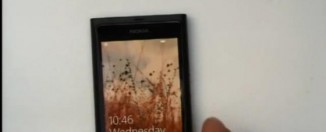Nokia to release 70mbps phones next year
The worlds of mobile phones and computing are converging rapidly, as both Nokia and Intel announced separately that they’re developing new technologies involving WiMax for 2008. Nokia announced they will be releasing WiMax phones in 2008 (LG and Samsung already have WiMax phones in South Korea), while Intel announced it is dropping support for 3G technologies from its Centrino range of laptop CPUs to focus exclusively on WiMax instead.
This could have huge implications for mobile network providers, and could lead to super-cheap, super-fast phones for us users. Read on to see how.
WiMax
WiMax (Worldwide Interoperability for Microwave Access ) is heralded as the next generation Wi-Fi technology, offering much greater speeds over much greater distances than current Wi-Fi. Typical WiMAx networks can reach up to 70Mbps and can cover up to 70km (but not both at the same time – the further away the transmitter and receiver, the slower the data transfer speed). Average speeds should be around 10Mbps, which is 3 times faster than existing HSDPA technology, and taking the mobile Internet well into broadband territory.
With Motorola also stating its aim to release a WiMax phone by 2008 (Sony Ericsson have yet to announce any firm plans), US network operator Sprint spending $3 billion on adding WiMax to its network, and now Intel also committing to the technology, WiMax is set for a secure future.
From a user’s perspective, this is excellent news, as WiMax’s vastly increased range makes it far more likely that you’ll be in range of a WiMax hotspot (one WiMax basestation can theoretically cover 70km). Within a short amount of time, high-speed downloads should therefore be easily accessible in most geographic areas.
Why Mobile Network Operators should fear WiMax
From the mobile network operator’s perspective, however, this is not good news. Unlike Wi-Fi, where the Wi-Fi basestation is located within the user’s house, a WiMax basestation is operated by an ISP (think of Wi-Fi as like a crodless phone, and WiMax as like a mobile phone). If you ISP adopts WiMax, you have mobile computing and a VoIP-based mobile telephony service within 70kms of the ISP’s WiMax basestation, all for the price of a traditional broadband service. All subsequent mobile data downloads and voice calls are then free. Why would you ever need to use your mobile network operator’s service (unless you’re miles from a WiMax basestation)?
If you have a high speed network available to you that’s always available across your town, and which uses the Internet rather than a mobile phone network (thereby being immensely cheaper), why would you use the mobile network at all? All your voice calls can be made using Skype or some other VoIP technology, and you’d never download data over the mobile network when you can do it for free over your own WiMax network.
VoIP Vandalism
This is one of the reasons why both Orange and Vodafone have chosen to disable the VoIP capabilities of Nokia’s new N95. The N95 comes with VoIP built-in (both a VoIP app, and built-in Wi-Fi), but VoIP is anathema to the network operators, as it means you make voice calls on the Internet, not over their networks – thus, they can’t charge you for it, and so start losing a shed load of revenue.
This is decidely short-term thinking, though. With Wi-Max coming very soon, people will ignore the mobile networks if they continue to charge horrific rates for mobile data and continue banning VoIP. Network operators need to wake up to the fact that they’re becoming Internet Service Providers and are increasingly competing with broadband providers.
Mobile Network Operators as ISPs
Their only hope of beating WiMax is to join it. They need to become ISPs themselves and offer users a mixed package of both Internet access and mobile phone access – and then charge the one fee for using both networks. This way, the user will pay the network operator whether they’re using VoIP, WiMax, or mobile network technology.
To a degree, Orange are already doing this, having taken over Wanadoo and offering combined fixed and mobile connections for a standard price. This is why their act of VoIP vandalism on the Nokia N95 is so curious, and reveals that although they have the equipment to act as a fixed and mobile service provider, they don’t have the business philosophy. They might be able to provide both types of network, but their actions show they really don’t want to!
Fortunately for us users, the future is inevitable. WiMax will be here in most handsets from most manufacturers next year, and will start appearing in laptops at the same time. WiMax services will then start plummeting in price, and its adoption rate will soar. As it soars, use of the mobile network will decrease as users choose WiMax as the cheaper alternative for the same service. As the network operators start losing revenue at an ever-accelerating pace, they’ll have no choice but to offer the user both a fixed and mobile service for the same tarrif – uncapped and at current home broadband prices.
Simple – the future’s bright, as they say (really, I should be a futurologist!)
[Source: TechRepublic, TechRepublic, Wikipedia]







